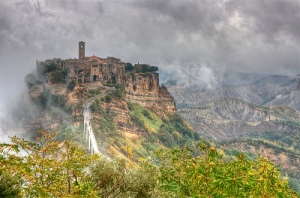I first visited Civita di Bagnoregio twenty years ago. Through the fog of mist and rain, only the memory of the dank odor of damp tuff and the image of desolate alleyways endure. Most appropriate for the Italian town that is known as La Città che Muore—the Dying City.
I saw her again ten years later, on a golden November day. Gloriously clinging to her high rock amidst a vast valley, Civita etched herself in my memory as she resisted her epithet.
No cars, no busloads of tourists. Only a Vespa buzzing past as I climbed the 300-meter long footbridge to the Porta Santa Maria—the only one left of the original five city gates. Sculptures of lions grasping human heads witnessed of an older resistance, when the city threw off the yoke of feudal oppression at the end of the fifteenth century. A worthy entrance to a place little changed since the Middle Ages.
When I entered the tiny souvenir shop behind the gate, the shopkeeper laid aside her needlework to share Civita’s tragedy with me. “Although the city looks like she’s been pulled from a fairy tale, in reality she’s been suffering from erosion and earthquakes. In 800 B.C., the Etruscans founded Civita on a large plateau between two valleys. However, the plateau wasn’t solid rock—it was brittle volcanic tuff.”
“So it just weathered?”
“About 1500 years ago, the erosion increased when the area was deforested to create farmland. The rivers and the rain had free reign and steadily washed away the sides of the plateau, leaving nothing but a narrow ridge.”
“And the earthquakes?”
She nodded. “Two earthquakes, in the seventeenth and eighteenth century, reduced the ridge to a pinnacle. And the erosion continues. A hundred years ago, Civita could still be accessed by a donkey path. Now we need a bridge.”
I suddenly became conscious of the fragility of the ground under my feet. “Aren’t people afraid to live here?”
“Most families fled after the last earthquake, because their houses were damaged. Despite the recent restorations, there are now fewer than ten residents.” Her face softened. “One of them is Maria. I’m sure you’ll meet her.”
Strolling through the narrow streets, I marveled at the omnipresent traces of history. The windows of a facade showing the blue sky—the house probably swallowed by an earthquake. Column stubs of a Roman temple in front of a Renaissance church. An alleyway ending in a chest-high wall that prevented me from stepping into the void. The grindstone of an ancient olive press that used to be operated by a donkey-powered treadmill until the 1960s.
I could not imagine that one day this timeless city would slide away.
As I rounded a corner, a soft voice greeted me.
“Buon giorno, signora. Do you want to see my garden? It gives a good view over the Calanchi Valley.” Blue eyes under silvery, well-groomed hair gently beckoned to me. Her right arm hung limp against her floral dress; her right foot was bent at an awkward angle.
Maria.
“I’d love to, grazie.” I reached inside my purse and placed two Euro in her opened left hand.
She smiled. “You will also love my little museum.”
On one side of her yard, a wall displayed a collection of worn garden tools, Etruscan artefacts, and giant potsherds.
“Look, there’s a Roman armor piece.” Maria pointed to something that could be a breastplate.
On the other side, the oblong garden invited me to walk to its far end, where a surreal landscape awaited me. Across the valley, gulches cut through barren hillsides, leaving sharp crests of white clay. In the distance rose the purple silhouette of the Apennines Mountains.
I sat on the wall that enclosed the garden, absorbing the view and the silence, amazed that such destruction can birth such a beauty.
This year, I returned to Civita, hoping to spend time in Maria’s garden. The small town was still perched fiercely atop its pinnacle, seemingly unaffected by wind and water. Flowerpots adorned balconies and staircases. From an open window, the aroma of garlic and tomato sauce wafted towards me. Cats were dozing in patches of sunshine. But I didn’t find Maria. Her garden was closed, the artefacts removed.
At the souvenir shop, I learned that Maria had deceased.
As I left Civita that day, I realized that the city is dying. But it is not only because she is losing her ground. She is dying because she is losing her souls.
***
This article was first published at the FaithWriters Weekly Writing Challenge.
For an aerial view of Civita di Bagnoregio, watch this short video on Youtube.


